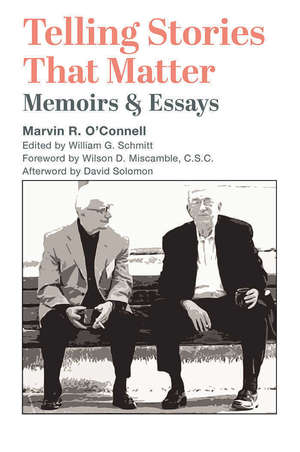Editor’s note: Father O’Connell, a longtime professor and chair of the University’s history department who died in 2016, was best known for his 2001 book, Edward Sorin, a comprehensive biography of Notre Dame’s founder. His Telling Stories That Matter: Memoirs and Essays was published in the fall by St. Augustine’s Press. In this excerpt, he describes his early days as a graduate student.
At dusk of my first Friday as a resident of the Howard Hall Annex, I suddenly heard outside my window the rustle of many feet, then members of an apparently pick-up band blaring out as they passed, the strains familiar even to me of the Notre Dame fight song. (Correction: It was forcefully pointed out to me early on that Notre Dame had no fight song, only a “Victory March.”) I went outside and was immediately caught up in the rush of the hundreds, swelling ultimately to thousands, of students sweeping across the campus from every direction toward the old Navy Drill Hall. Thus was I introduced to the Notre Dame pep rally, held before every home football game. . . .

The 1956 football season ushered in by that pep rally had, however, little to recommend it. The 2 and 8 record was [one of] the worst in the history of Notre Dame, before or since. All the more remarkable was it then that Paul Hornung won the Heisman Trophy, the only member of a losing team ever to do so. He was popularly dubbed the Golden Boy, and his prodigious accomplishments on the field, on both sides of the ball, clearly justified the nickname. He contributed to it in his own flamboyant style too: when he ran back to the sideline for a brief rest, always to much cheering from the crowd, he took off his helmet so that the sunshine could brighten his yellow hair. . . .
Aside from Hornung’s heroics, the sport during the 1956 season pretty much managed to depress the ardent Irish fan. Perhaps it could be summed up in this wispy memory. We students sat in the northeast corner of the stadium. Late in the loss to Purdue, the Notre Dame team had driven almost to the Boilermakers’ goal line at the south end. At the distance we could barely see the bodies banging against each other, but we could hear the sepulchral voice of the public address announcer. “Pietrosante fails to gain,” he intoned solemnly. More banging down south, and then he said it again. And finally a third time. So it was that even tough fullback Nick Pietrosante could not breach the Boilermakers’ defensive line. The young Irish coach, Terry Brennan, himself a Notre Dame gridiron hero of a few years before, walked the sideline glumly, hands in pockets.
But the ambience was a different matter. For me, whose education up to this time had been confined to seminaries, the very color and excitement of Notre Dame home football games was a new and exhilarating experience. And over all the years that followed, through all the home games I attended — a hundred, probably more — it always remained so, always raised the goose bumps on the back of my neck as it had on that September day in 1956. The vast crowd, first of all, 60,000 loud and boisterous and mostly good-natured folks. The marching band, with the Irish Guard, delightful in sight and sound. Just before the kickoff the raising of the flag and the singing of “America the Beautiful.” Then lots of other songs, to be sure more parochial ones, like “Hike, Notre Dame”: “The march is on, no brain or brawn, can stop the charge of fighting men.” Followed by the rousing chorus of the inimitable “Victory March.” In those days the students of Saint Mary’s College sat as a separate group to our left. During the halftime entertainment the band always concluded its program by assembling in front of the girls and playing, at an adagio pace, “The Bells of St. Mary’s.” (At that remote and unenlightened era it was not yet considered impertinent to refer to the collegiate women as “girls.”)
At the end of October the University of Oklahoma came to town. Led by legendary coach Bud Wilkinson, the undefeated Sooners arrived ranked No. 1 in the nation, and they proceeded with great efficiency to demonstrate why. Their dominance was total. Their last touchdown, in the middle of the fourth quarter, brought the score to 40 to 0.
In the student section we graduates sat in the upper rows, behind the undergraduates, with the band at the lowest level, next to the field. And all of us could see as our team lined up to receive the Oklahoma kickoff how dispirited and weary they appeared. The cheerleaders, meanwhile, seemed stunned. A momentary hush fell over the crowd and then, 20 or 30 rows below where I was sitting, a single student began to shout, “Here come the Irish!” Then 10 more undergraduates joined him and then a hundred and then thousands, “Here come the Irish! Here come the Irish!” Finally, as though by some long determined and fateful schedule, the band broke into the “Victory March.”
The effect of this traditional challenge to the opposing team, no more this day than a hopeless gesture, nonetheless had a striking effect on the players; we could see their sagging shoulders straightened, their no longer bowed heads thrust forward, their arms swinging impatiently at their sides. “Here come the Irish!”
No magical result emerged out of this rhapsodic moment; the humiliating defeat was sealed a few minutes later. But for me the boldness of the cheering for our players when they had no chance to win, and its effect on them, proved to be a rite of passage. I finally admitted to myself that there must be something to this Notre Dame mystique. Indeed, on that October day I became a Notre Dame man.